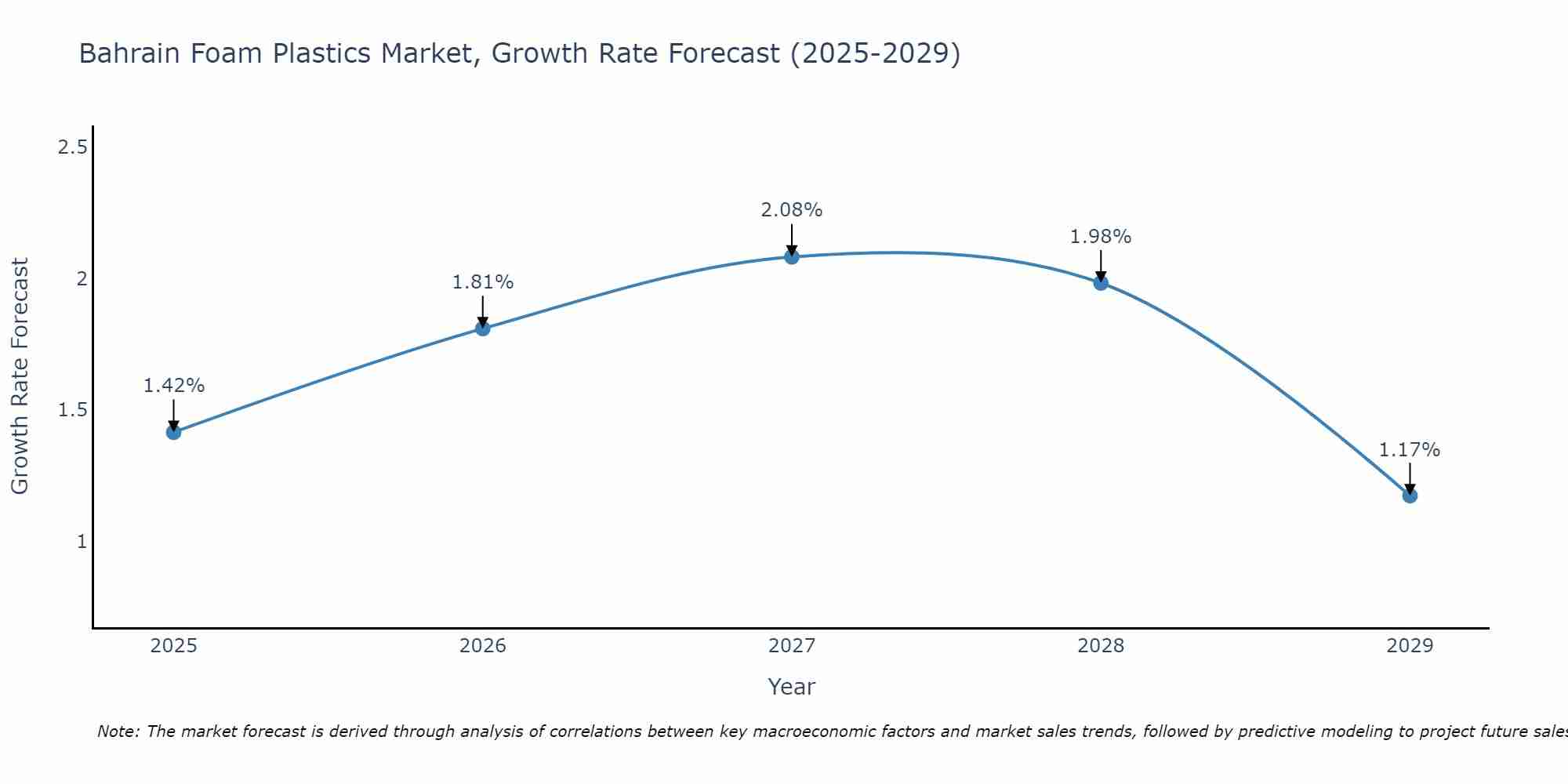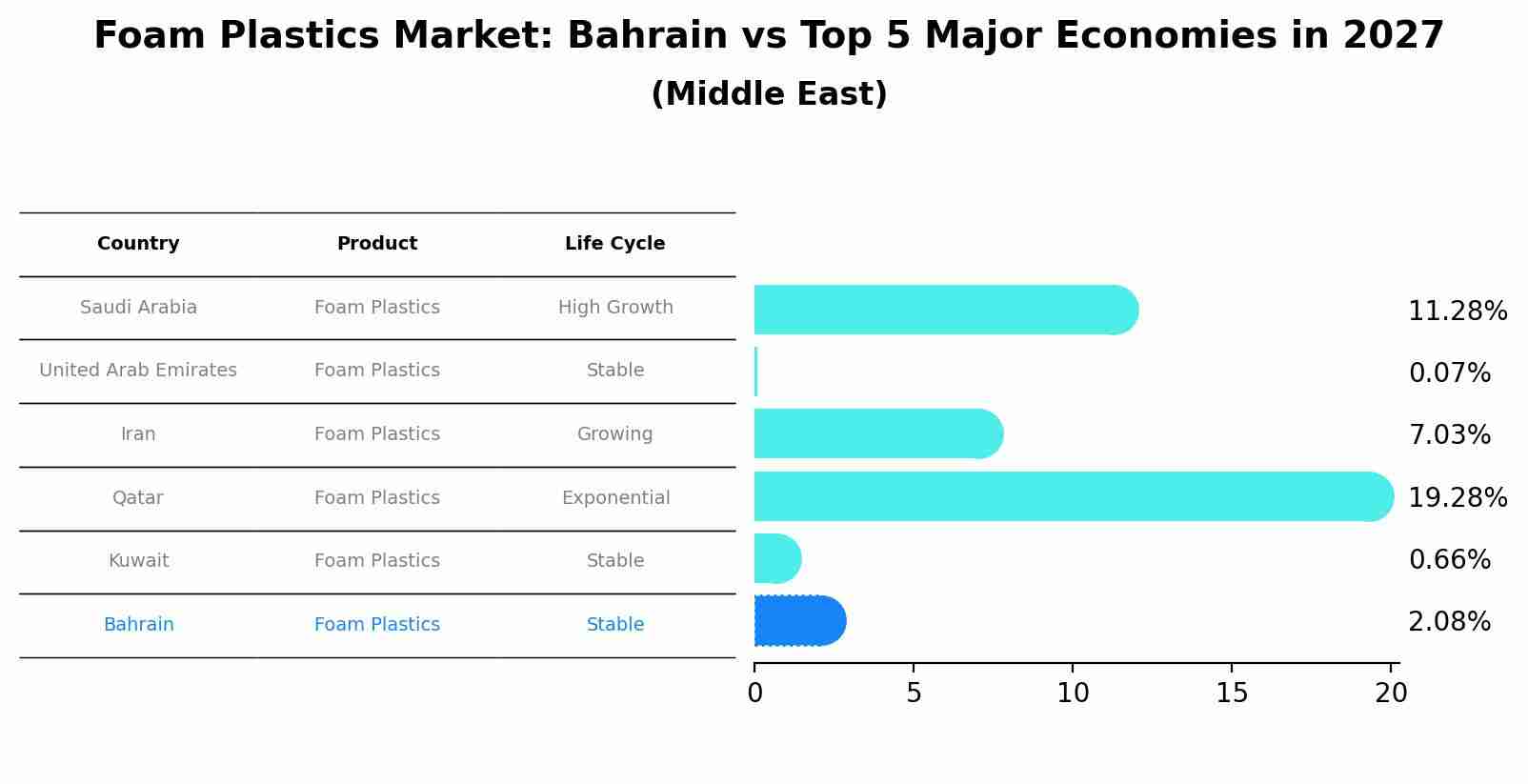Bahrain Foam Plastics Market Outlook | Growth, Forecast, COVID-19 IMPACT, Size, Companies, Share, Industry, Trends, Revenue, Analysis & Value
| Product Code: ETC325484 | Publication Date: Aug 2022 | Updated Date: Aug 2025 | Product Type: Market Research Report | |
| Publisher: 6Wresearch | Author: Summon Dutta | No. of Pages: 75 | No. of Figures: 35 | No. of Tables: 20 |
Bahrain Foam Plastics Market Size Growth Rate
The Bahrain Foam Plastics Market is projected to witness mixed growth rate patterns during 2025 to 2029. The growth rate begins at 1.42% in 2025, climbs to a high of 2.08% in 2027, and moderates to 1.17% by 2029.

Foam Plastics Market: Bahrain vs Top 5 Major Economies in 2027 (Middle East)
By 2027, the Foam Plastics market in Bahrain is anticipated to reach a growth rate of 2.08%, as part of an increasingly competitive Middle East region, where Saudi Arabia remains at the forefront, supported by United Arab Emirates, Iran, Qatar and Kuwait, driving innovations and market adoption across sectors.

Bahrain Foam Plastics Market Synopsis
The foam plastics market in Bahrain is expanding due to strong demand in the construction, packaging, automotive, and insulation sectors. These materials offer lightweight, shock-absorbing, and thermally insulating properties, making them ideal for energy-efficient building systems. Rising consumer demand for comfort and durability in furniture and bedding also supports this markets growth.
Trends of the market
The foam plastics market in Bahrain is experiencing steady growth, driven primarily by demand from the construction, packaging, and automotive sectors. Increasing urbanization and infrastructure development are fueling the need for lightweight, insulating materials. Additionally, the shift towards sustainable and energy-efficient building materials is encouraging manufacturers to invest in innovative foam solutions, including bio-based and recyclable foam plastics.
Challenges of the market
The foam plastics market in Bahrain is encountering challenges from the increasing demand for sustainable and energy-efficient products. While foam plastics are widely used in insulation, packaging, and automotive applications, the environmental concerns over plastic waste are forcing manufacturers to consider more eco-friendly alternatives, such as biodegradable or recyclable foams. Additionally, the market is impacted by the rising cost of raw materials, such as polystyrene and polyurethane, which are key components in foam production. The growing regulatory pressure to reduce plastic consumption and improve recycling rates is adding complexity to the market dynamics.
Investment opportunities in the Market
Foam plastics are widely used in insulation, packaging, and furniture. With real estate and manufacturing sectors active in Bahrain, investing in foam productionparticularly polyurethane and polystyrenecan meet domestic demand. Theres also room for innovation in fire-retardant, recyclable, or bio-based foams that meet new building codes and environmental standards.
Government Policy of the market
The foam plastics market in Bahrain is closely tied to the construction, automotive, and packaging industries. Government regulations, under the Supreme Council for Environment and the Ministry of Industry and Commerce, emphasize the safe use and disposal of plastic foams, especially those containing isocyanates and other potentially hazardous chemicals. Policies support the shift toward eco-friendly and recyclable foam products. Additionally, tax incentives and import duty exemptions are in place to encourage businesses that use sustainable or flame-retardant foam plastics in building insulation and consumer products.
Key Highlights of the Report:
- Bahrain Foam Plastics Market Outlook
- Market Size of Bahrain Foam Plastics Market, 2021
- Forecast of Bahrain Foam Plastics Market, 2031
- Historical Data and Forecast of Bahrain Foam Plastics Revenues & Volume for the Period 2018 - 2031
- Bahrain Foam Plastics Market Trend Evolution
- Bahrain Foam Plastics Market Drivers and Challenges
- Bahrain Foam Plastics Price Trends
- Bahrain Foam Plastics Porter's Five Forces
- Bahrain Foam Plastics Industry Life Cycle
- Historical Data and Forecast of Bahrain Foam Plastics Market Revenues & Volume By Type for the Period 2018 - 2031
- Historical Data and Forecast of Bahrain Foam Plastics Market Revenues & Volume By Polyurethane for the Period 2018 - 2031
- Historical Data and Forecast of Bahrain Foam Plastics Market Revenues & Volume By Polystyrene for the Period 2018 - 2031
- Historical Data and Forecast of Bahrain Foam Plastics Market Revenues & Volume By Polyolefin for the Period 2018 - 2031
- Historical Data and Forecast of Bahrain Foam Plastics Market Revenues & Volume By Phenolic for the Period 2018 - 2031
- Historical Data and Forecast of Bahrain Foam Plastics Market Revenues & Volume By Others for the Period 2018 - 2031
- Historical Data and Forecast of Bahrain Foam Plastics Market Revenues & Volume By Application for the Period 2018 - 2031
- Historical Data and Forecast of Bahrain Foam Plastics Market Revenues & Volume By Building & Construction for the Period 2018 - 2031
- Historical Data and Forecast of Bahrain Foam Plastics Market Revenues & Volume By Packaging for the Period 2018 - 2031
- Historical Data and Forecast of Bahrain Foam Plastics Market Revenues & Volume By Automotive for the Period 2018 - 2031
- Historical Data and Forecast of Bahrain Foam Plastics Market Revenues & Volume By Furniture & Bedding for the Period 2018 - 2031
- Historical Data and Forecast of Bahrain Foam Plastics Market Revenues & Volume By Footwear, Sports, & Recreational for the Period 2018 - 2031
- Historical Data and Forecast of Bahrain Foam Plastics Market Revenues & Volume By Others for the Period 2018 - 2031
- Bahrain Foam Plastics Import Export Trade Statistics
- Market Opportunity Assessment By Type
- Market Opportunity Assessment By Application
- Bahrain Foam Plastics Top Companies Market Share
- Bahrain Foam Plastics Competitive Benchmarking By Technical and Operational Parameters
- Bahrain Foam Plastics Company Profiles
- Bahrain Foam Plastics Key Strategic Recommendations
Frequently Asked Questions About the Market Study (FAQs):
1 Executive Summary |
2 Introduction |
2.1 Key Highlights of the Report |
2.2 Report Description |
2.3 Market Scope & Segmentation |
2.4 Research Methodology |
2.5 Assumptions |
3 Bahrain Foam Plastics Market Overview |
3.1 Bahrain Country Macro Economic Indicators |
3.2 Bahrain Foam Plastics Market Revenues & Volume, 2021 & 2031F |
3.3 Bahrain Foam Plastics Market - Industry Life Cycle |
3.4 Bahrain Foam Plastics Market - Porter's Five Forces |
3.5 Bahrain Foam Plastics Market Revenues & Volume Share, By Type, 2021 & 2031F |
3.6 Bahrain Foam Plastics Market Revenues & Volume Share, By Application, 2021 & 2031F |
4 Bahrain Foam Plastics Market Dynamics |
4.1 Impact Analysis |
4.2 Market Drivers |
4.2.1 Increasing demand for lightweight and durable packaging solutions |
4.2.2 Growing construction industry in Bahrain |
4.2.3 Favorable government regulations promoting the use of foam plastics |
4.3 Market Restraints |
4.3.1 Fluctuating raw material prices impacting production costs |
4.3.2 Environmental concerns related to the disposal of foam plastics waste |
5 Bahrain Foam Plastics Market Trends |
6 Bahrain Foam Plastics Market, By Types |
6.1 Bahrain Foam Plastics Market, By Type |
6.1.1 Overview and Analysis |
6.1.2 Bahrain Foam Plastics Market Revenues & Volume, By Type, 2021-2031F |
6.1.3 Bahrain Foam Plastics Market Revenues & Volume, By Polyurethane, 2021-2031F |
6.1.4 Bahrain Foam Plastics Market Revenues & Volume, By Polystyrene, 2021-2031F |
6.1.5 Bahrain Foam Plastics Market Revenues & Volume, By Polyolefin, 2021-2031F |
6.1.6 Bahrain Foam Plastics Market Revenues & Volume, By Phenolic, 2021-2031F |
6.1.7 Bahrain Foam Plastics Market Revenues & Volume, By Others, 2021-2031F |
6.2 Bahrain Foam Plastics Market, By Application |
6.2.1 Overview and Analysis |
6.2.2 Bahrain Foam Plastics Market Revenues & Volume, By Building & Construction, 2021-2031F |
6.2.3 Bahrain Foam Plastics Market Revenues & Volume, By Packaging, 2021-2031F |
6.2.4 Bahrain Foam Plastics Market Revenues & Volume, By Automotive, 2021-2031F |
6.2.5 Bahrain Foam Plastics Market Revenues & Volume, By Furniture & Bedding, 2021-2031F |
6.2.6 Bahrain Foam Plastics Market Revenues & Volume, By Footwear, Sports, & Recreational, 2021-2031F |
6.2.7 Bahrain Foam Plastics Market Revenues & Volume, By Others, 2021-2031F |
7 Bahrain Foam Plastics Market Import-Export Trade Statistics |
7.1 Bahrain Foam Plastics Market Export to Major Countries |
7.2 Bahrain Foam Plastics Market Imports from Major Countries |
8 Bahrain Foam Plastics Market Key Performance Indicators |
8.1 Recycling rate of foam plastics in Bahrain |
8.2 Adoption rate of foam plastics in new construction projects |
8.3 Investment in research and development for sustainable foam plastics alternatives |
9 Bahrain Foam Plastics Market - Opportunity Assessment |
9.1 Bahrain Foam Plastics Market Opportunity Assessment, By Type, 2021 & 2031F |
9.2 Bahrain Foam Plastics Market Opportunity Assessment, By Application, 2021 & 2031F |
10 Bahrain Foam Plastics Market - Competitive Landscape |
10.1 Bahrain Foam Plastics Market Revenue Share, By Companies, 2021 |
10.2 Bahrain Foam Plastics Market Competitive Benchmarking, By Operating and Technical Parameters |
11 Company Profiles |
12 Recommendations |
13 Disclaimer |
- Single User License$ 1,995
- Department License$ 2,400
- Site License$ 3,120
- Global License$ 3,795
Search
Thought Leadership and Analyst Meet
Our Clients
Related Reports
- Afghanistan Apparel Market (2026-2032) | Growth, Outlook, Industry, Segmentation, Forecast, Size, Companies, Trends, Value, Share, Analysis & Revenue
- Canada Oil and Gas Market (2026-2032) | Share, Segmentation, Value, Industry, Trends, Forecast, Analysis, Size & Revenue, Growth, Competitive Landscape, Outlook, Companies
- Germany Breakfast Food Market (2026-2032) | Industry, Share, Growth, Size, Companies, Value, Analysis, Revenue, Trends, Forecast & Outlook
- Australia Briquette Market (2025-2031) | Growth, Size, Revenue, Forecast, Analysis, Trends, Value, Share, Industry & Companies
- Vietnam System Integrator Market (2025-2031) | Size, Companies, Analysis, Industry, Value, Forecast, Growth, Trends, Revenue & Share
- ASEAN and Thailand Brain Health Supplements Market (2025-2031) | Strategy, Consumer Insights, Analysis, Investment Trends, Opportunities, Growth, Size, Share, Industry, Revenue, Segments, Value, Segmentation, Supply, Forecast, Restraints, Outlook, Competition, Drivers, Trends, Demand, Pricing Analysis, Competitive, Strategic Insights, Companies, Challenges
- ASEAN Bearings Market (2025-2031) | Strategy, Consumer Insights, Analysis, Investment Trends, Opportunities, Growth, Size, Share, Industry, Revenue, Segments, Value, Segmentation, Supply, Forecast, Restraints, Outlook, Competition, Drivers, Trends, Demand, Pricing Analysis, Competitive, Strategic Insights, Companies, Challenges
- Europe Flooring Market (2025-2031) | Outlook, Share, Industry, Trends, Forecast, Companies, Revenue, Size, Analysis, Growth & Value
- Saudi Arabia Manlift Market (2025-2031) | Outlook, Size, Growth, Trends, Companies, Industry, Revenue, Value, Share, Forecast & Analysis
- Uganda Excavator, Crane, and Wheel Loaders Market (2025-2031) | Strategy, Consumer Insights, Analysis, Investment Trends, Opportunities, Growth, Size, Share, Industry, Revenue, Segments, Value, Segmentation, Supply, Forecast, Restraints, Outlook, Competition, Drivers, Trends, Demand, Pricing Analysis, Competitive, Strategic Insights, Companies, Challenges
Industry Events and Analyst Meet
Whitepaper
- Middle East & Africa Commercial Security Market Click here to view more.
- Middle East & Africa Fire Safety Systems & Equipment Market Click here to view more.
- GCC Drone Market Click here to view more.
- Middle East Lighting Fixture Market Click here to view more.
- GCC Physical & Perimeter Security Market Click here to view more.
6WResearch In News
- Doha a strategic location for EV manufacturing hub: IPA Qatar
- Demand for luxury TVs surging in the GCC, says Samsung
- Empowering Growth: The Thriving Journey of Bangladesh’s Cable Industry
- Demand for luxury TVs surging in the GCC, says Samsung
- Video call with a traditional healer? Once unthinkable, it’s now common in South Africa
- Intelligent Buildings To Smooth GCC’s Path To Net Zero


















